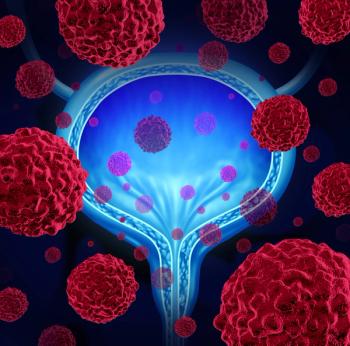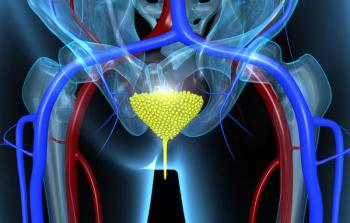
Oncology NEWS International
- Oncology NEWS International Vol 15 No 9
- Volume 15
- Issue 9
Bladder Ca Screening Reduces Cancer-Specific Mortality
At-home hematuria screening appears to lessen the frequency of invasive bladder cancer and reduce bladder-cancer-specific mortality, according to results of a study
ATLANTA-At-home hematuria screening appears to lessen the frequency of invasive bladder cancer and reduce bladder-cancer-specific mortality, according to results of a study presented at the 101st Annual Meeting of the American Urological Association (abstract 881).
Men with bladder cancer detected by screening were significantly less likely to have invasive bladder cancer and were significantly less likely to die over a 14-year period than a nonscreened population of men with bladder cancer.
"Screening permitted the diagnosis of high-grade cancers at a preinvasive stage when they can be treated better," study investigator Edward M. Messing, MD, professor of urology, University of Rochester School of Medicine, said at a press conference.
In the study, which was designed in 1987, a total of 1,575 men at moderate risk of developing bladder cancer (at least 50 years of age) performed at-home hematuria testing daily for 14 days, then repeated the testing 9 months later. Men who tested positive underwent standard hematuria work-ups.
A total of 16.4% (268) of screened men tested positive for hematuria at least once. Of those, 8% (21 patients) were diagnosed with bladder cancer. The disease was low-grade (G1-G2 and Ta-T1) in 11 (52%) of these men. The proportion of low-grade cancers was similar (60%) in a contemporary population of 509 men with bladder cancer. However, among those diagnosed with high-grade bladder cancer, the men diagnosed based on screening were significantly less likely to have invasive (stage T2+) bladder cancer. Invasive cancers accounted for 60% of high-grade bladder cancers in the unscreened bladder cancer patients vs 10% in the screened population.
Bladder Cancer Mortality
No men with bladder cancer detected by screening had died of bladder cancer during the follow-up period. However, bladder cancer was fatal for 20.4% of the unscreened population, with a median survival of 1.8 years after diagnosis. Overall mortality was significantly lower in the screened men with bladder cancer vs the unscreened men (74% vs 43%) due to reduced bladder cancer mortality.
Interestingly, mortality from non-bladder-cancer causes was similar between the two groups and was similar regardless of the disease stage. Dr. Messing expressed his surprise that non-bladder-cancer mortality was not higher in men with higher grade disease, given the association between bladder cancer and environmental carcinogens. "I would have thought that the men with high-grade cancers would have had more exposures so that their non-bladder-cancer causes of death would have been faster, too, but it's not what we found. Why some people don't get high-grade cancer and other people do, we don't know."
Outcomes of Non-Bladder-Ca Pts
In the same study, Dr. Messing and his colleagues evaluated the long-term outcome of the 91% of patients who had a work-up for hematuria but were not diagnosed with bladder cancer (abstract 883). Ralph Madeb, MD, of the Department of Urology, University of Rochester School of Medicine, retrieved the follow-up data for this investigation. Dr. Madeb was involved in both studies and was lead author for abstract 883.
Over the 14-year follow-up, only two of these men with a negative work-up (0.85%) subsequently developed bladder cancer. These cases were diagnosed at 6.6 and 11.4 years after the negative work-up. Current AUA guidelines suggest long-term follow-up and repeat evaluations for these patients, but Dr. Messing now believes that "once you do a complete work-up for asymptomatic hematuria, you probably don't need to follow these individuals."
Moreover, he said, only 0.95% of the men who initially tested negative for hematuria subsequently developed bladder cancer; all diagnoses were at least a year after the screening, indicating that the hematuria screening was accurate at the time. Dr. Messing suggested that a randomized prospective study of men with equivalent risk factors is warranted to confirm these results.
Articles in this issue
over 19 years ago
Exjade Gains Approval in EUover 19 years ago
President's Cancer Panel Assesses Progress in Two Areasover 19 years ago
Cognitive Rx Reduces Depression in Breast Ca Ptsover 19 years ago
Nurses Develop Evidence-Based Guidelines for Mucositisover 19 years ago
Anastrozole Therapy for Breast Cancer Affects Bone Healthover 19 years ago
Is Demand for Trial Subjects Outpacing Supply?over 19 years ago
Postchemo Disappearance of Liver Mets Doesn't Mean Cureover 19 years ago
Aromasin-Related Bone Loss Affected by Vitamin D LevelsNewsletter
Stay up to date on recent advances in the multidisciplinary approach to cancer.

















































































